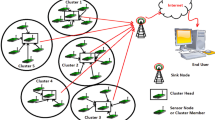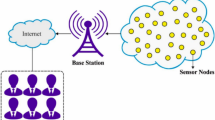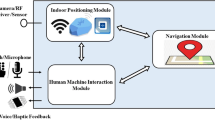Abstract
UWB positioning can be modeled as an optimization problem for a fitness function, which is resolved through the conventional whale optimization algorithm. The fitness function used in the conventional whale positioning algorithm does not use the range measurement data between labels, and the range measurement data is incomplete, which leads to a limited improvement in its positioning accuracy. Consequently, a novel whale cooperative positioning algorithm that can increase positioning accuracy is presented in this paper. First, a fitness function is established during the positioning process that contains the range measurement data between the labels to improve positioning accuracy. Then, the conventional whale positioning method provides a good initial position for the labels, enabling the proposed algorithm to quickly search for the optimal position. Finally, Levy flight mode is adopted to prevent the positioning result from converging to the local optimal solution. According to simulation results, the proposed algorithm can provide better positioning accuracy than the conventional whale positioning algorithm while realizing simultaneous positioning of all the labels.










Similar content being viewed by others
Availability of data and material
The datasets generated during the current study are available from the corresponding author on reasonable request.
References
Wen, R., Schoof, E., & Chapman, A. (2022). Clock rigidity and joint position-clock estimation in ultra-wideband sensor networks. IEEE Transactions on Control of Network Systems, 10, 1209–1221.
Wang, J., Yang, J., & Wang, M. (2021) Device-free localization and tracking of multiple person in UWB sensor networks. In International Conference on Sensing, Measurement & Data Analytics in the era of Artificial Intelligence, pp. 1–7.
Josifovic, K. M., Vujicic, V. L., Misailovic, S. D., & Markovic, G. B. (2020). Bilateration-based localization for UWB-based wireless sensor networks. Telecommunications Forum. https://doi.org/10.1109/TELFOR51502.2020.9306627
V, V., & Guruprakash, C. D. (2022) A review on smart agricultural applications: crop yield and plant disease prediction. In International Conference on Applied Artificial Intelligence and Computing, pp. 885–892.
Elsanhoury, M., et al. (2022). Precision positioning for smart logistics using Ultra-wideband technology-based indoor navigation: a review. IEEE Access, 10, 44413–44445.
Schmidt, J. F., Chernov, D., & Bettstetter, C. (2020). Towards industrial Ultra-wideband networks: experiments for machine vibration monitoring. IEEE Access, 8, 42576–42583.
Maali, A., Baudoin, G., & Mesloub, A. (2017) Improved energy detection receiver for ranging in IEEE 802.15.4a standard. In European Conference on Antennas and Propagation, pp. 1860–1863.
Li, Y., Maorong, J., Qiang, L., Guili, Y., & Kai, D. (2018) Research on the IR-UWB ranging algorithm in outdoor Near-ground environment. In International Conference on Sensor Networks and Signal Processing, pp. 504–507.
Liu, Q., Wu, Z., Yin, Z., Wu, M., & Ma, B. (2020) A novel multiuser UWB ranging scheme in NLOS indoor environment. In International Conference on Telecommunications, pp. 1–5.
Sobron, I., Landa, I., Eizmendi, I., & Velez, M. (2020) Adaptive TOA estimation with imperfect LOS and NLOS knowledge in UWB positioning systems. IEEE Sensors, pp. 1–4.
Fenghao, L., Jun, S., ZhiWei, Y., XiaoXiao, S., & Feng, C. (2019) A wireless sensor network location algorithm based on whale algorithm. In IEEE International Conference on Intelligent Data Acquisition and Advanced Computing Systems: Technology and Applications.
Lakshmishree, K. P., & Nirmala, M. B. (2018) Localization in wireless sensor networks with optimization and security schemes-a review. In International Conference on Intelligent Computing and Control Systems.
Chen, Y., Shen, C., Zhang, K., Xu, L., & Huang, X. (2020) TDOA positioning method based on taylor series expansion based on cuckoo search algorithm. In International Conference on Virtual Reality and Intelligent Systems, pp. 986–989.
Li, N., Shen, C., Zhang, K., & Huang, X. (2019) The TDOA algorithm based on BP neural network optimized by cuckoo search. In International Conference on Robots Intelligent System, pp. 539–542.
Cheng, J., & Xia, L. (2016). An effective cuckoo search algorithm for node positioning in wireless sensor network. Sensors (Switzerland), 16(9), 1–17.
Fenghao, L., Jun, S., Chunzhi, W., Yucheng, Z., Ming, W., & Xianjing, Z. (2021) An indoor localization method based on cauchy inverse whale optimization algorithm. In IEEE International Conference on Computer Science & Education, pp. 617–621.
Shakila, R., & Paramasivan, B. (2021). An improved range based localization using whale optimization algorithm in underwater wireless sensor network. Journal of Ambient Intelligence and Humanized Computing, 12, 6479–6489.
Xuezhen, C., Shanpei, W., Xiaoqing, L., Xingjun, L., Kun, C., & Jiming, L. (2020) DV-Hop underground positioning algorithm based on parameter disturbance WOA. In Chinese Automation Congress, pp. 3187–3192.
Pingzhang, G., Bo, H., & Zhaoyang, Y. (2021) A node location algorithm based on improved whale optimization in wireless sensor networks. In Wireless Communications and Mobile Computing, pp. 1–17.
Bacanin, N., Tuba, E., Zivkovic, M., Strumberger, I., & Tuba, M. (2021). Whale optimization algorithm with exploratory move for wireless sensor networks localization. Advances in Intelligent Systems and Computing. https://doi.org/10.1007/978-3-030-49336-3_33
Zhao, C., & Wang, B. (2019) A UWB/Bluetooth fusion algorithm for indoor localization. In Chinese Control Conference, pp. 4142–4146.
Monica, S., & Ferrari, G. (2014) Accurate indoor localization with UWB wireless sensor networks. In IEEE International WETICE Conference, pp. 287–289.
Qin, X., et al. (2021). An improved Cuckoo search localization algorithm for UWB sensor networks. Wireless Netwoks, 27, 527–535.
Funding
This work was supported in part by the National Natural Science Foundation of China (62001272).
Author information
Authors and Affiliations
Contributions
BX wrote the main manuscript text. NX and LZ revised the manuscript.
Corresponding author
Ethics declarations
Conflict of interest
The authors declared that they have no Conflict of interest.
Additional information
Publisher's Note
Springer Nature remains neutral with regard to jurisdictional claims in published maps and institutional affiliations.
Rights and permissions
Springer Nature or its licensor (e.g. a society or other partner) holds exclusive rights to this article under a publishing agreement with the author(s) or other rightsholder(s); author self-archiving of the accepted manuscript version of this article is solely governed by the terms of such publishing agreement and applicable law.
About this article
Cite this article
Xia, B., Xie, N. & Zhang, L. Novel Whale Cooperative Positioning Algorithm for UWB Sensor Networks. Wireless Pers Commun 135, 2421–2438 (2024). https://doi.org/10.1007/s11277-024-11175-3
Accepted:
Published:
Issue Date:
DOI: https://doi.org/10.1007/s11277-024-11175-3




